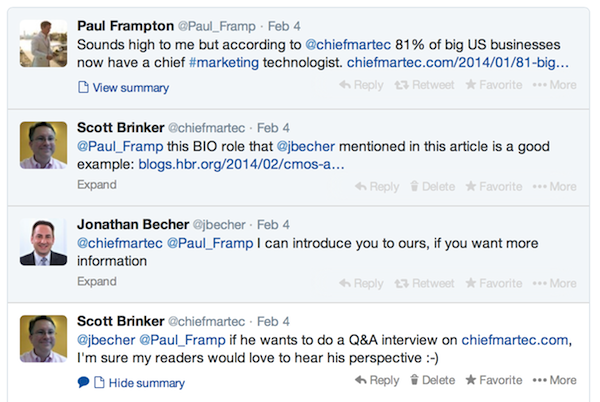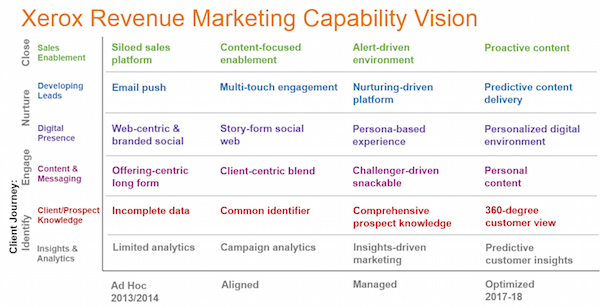When I posted my presentation The Marketing Technologist: Neo of the Marketing Matrix a few months ago, one of the people who commented on it was Nancy Fessatidis, VP of Marketing Operations at SAP:
Great post Scott. The CMT role has served us well at SAP. We call this our Business Information Officer (BIO). It’s a critical role not just in Marketing but in every key line of business — to help translate our business needs into an enterprise architecture roadmap.
My ears pricked up, as public sightings of chief marketing technologists are still relatively rare. When Gartner released their latest research last month showing that 81% of large companies now have a chief marketing technologist type role, my reaction was both (a) awesome and (b) where are they hiding?
In a subsequent exchange on Twitter, around a Harvard Business blog post on why CMOs and CIOs Need to Get Along to Make Big Data Work, the CMO of SAP, Jonathan Becher, actually chimed in to offer an introduction to their chief marketing technologist:
(As an aside, this is why I love Twitter.)
Of course, one of the reasons it’s hard to find chief marketing technologists is that they go by many different titles. Andreas Starke is SAP Marketing’s Business Information Officer (BIO) — but he’s essentially a CMT. And when we got in touch, he was kind enough to take some time to participate in the following Q&A about marketing technology management at a multi-billion dollar global company like SAP.
1. Can you tell us a little about your background and your current role at SAP?
I have more than 20 years of professional experience in various business and IT roles. I started as a consultant and project manager at SAP, managing global implementations with multi-national clients at that time
In my next role with global sales operations, I was the global program manager for the first internal CRM implementation at SAP, including a worldwide deployment to Sales & Marketing. For the past ten years, I have been in leadership roles, first with SAP IT and since 2009 with SAP Marketing.
Today in my role as Marketing Business Information Officer, I’m responsible for marketing’s technology strategy and respective investments, in close collaboration with SAP product management and corporate IT.
2. Can you elaborate on this BIO role at SAP? How did it come about? How has it changed the way marketing interacts with IT?
At SAP, the Business Information Officer (BIO) function was developed to establish a tighter integration between the lines of business and our IT partners.
The role of the Marketing BIO is to understand and translate marketing’s business strategy into a joint IT enterprise architecture strategy and a technology investment portfolio for marketing. The BIO team also supports the CIO and the IT organization on topics such as IT governance and security, to ensure compliance across the marketing organization.
[My role] is to understand and translate marketing’s business strategy into a joint IT enterprise architecture strategy and a technology investment portfolio for marketing.
Most importantly, by managing a tighter integration between marketing and our IT partners, the BIO ensures the success of our programs by providing business context to the requirements and evaluating the “goodness of fit” for the proposed solutions.
SAP’s BIO maintains a dotted reporting line to the CIO. Through this engagement, we have enabled a single interaction point for the marketing business to interact with technology experts, with a long term view of the company’s goals in mind. This ultimately simplifies the efforts for defining, executing and gaining executive support for a technology project. This relationship has been influential in providing top-down support for IT engagement across strategic programs such as marketing automation, content management, CRM on HANA, and HANA analytics.
3. What are the toughest challenges in your role? How do you approach them?
I think the toughest challenge right now is related to the way marketing is changing. Marketing nowadays is confronted with changes in buying behavior, evolving digital technology, and the need to manage big data across all engagement channels. In my mind, technology is a critical success factor for marketing.
In my mind, technology is a critical success factor for marketing.
In order to keep up with these new business requirements though, marketing departments need to move away from “siloed” marketing tools towards an integrated marketing platform, which allows the management of big data and supports the end-to-end process towards sales. Even though the marketing technology space is vast, with new niche tools constantly evolving, it is critical that we keep the focus on the bigger long term architecture for SAP to enable our long-term targets.
So, in my role today, it’s about the balance to keep the marketing business focused on core strategic investments, while enabling innovation with new technologies and processes. In this regard, our team utilizes enterprise architecture as a foundation component, to ensure each investment fits with the long term goals — but also works with small pilot teams to innovate with new technologies.
It’s about the balance to keep the marketing business focused on core strategic investments, while enabling innovation with new technologies.
4. Given your perspective, how is technology changing the management and culture of marketing?
As mentioned before, technology has become a fundamental building block for the marketing organization and is a driving factor in SAP Marketing’s transformation into a streamlined data and insights driven organization.
SAP Marketing has been on the path for many years to simplify processes and technology, utilizing both SAP and key partner technologies. The automation and simplification has allowed teams to refocus on driving insights and value instead of pure operational tasks.
SAP Marketing has been on the path for many years to simplify processes and technology.
A critical technology transformation was the consolidation of all marketing data into SAP’s HANA database, to provide real-time insights and management of each stage of the buying cycle. This is giving us the platform to standardize processes and better integrate with sales teams bringing the organizations much closer together.
So, technology is enabling the business to refocus much more on the “science of marketing” and ultimately improving the customer experience.
5. What advice would you give to a CMO who doesn’t yet have someone like you in their organization? Why should they have a BIO? Where should the look for one?
Due to marketing’s growing dependence on technology, CMOs are expected to spend significantly more on technology in the coming years. From my perspective, it is therefore essential to have the combined business and technology expertise of such a role as a critical function within marketing organizations.
It is therefore essential to have the combined business and technology expertise of such a role as a critical function within marketing organizations.
The BIO function is the key component to bring not only the strategic and technological views together, but also to align the organizations to drive a holistic roadmap for marketing.
This single point of contact for technology streamlines the complexity of working with the COO and IT groups by enabling a central technology planning and execution function for marketing. In order to do so, I have implemented a robust enterprise architecture practice, along with processes to ensure an ongoing focus on strategy, simplification, and automation.
6. If a young person reads this and says, “Wow, this BIO role sounds awesome,” what career advice would you give them?
Go for it! It is really the most exciting job in my career as it combines marketing and technology, so you are always a part of constant innovation and new business trends.
Thank you, Andreas — and thank you Nancy and Jonathan!




